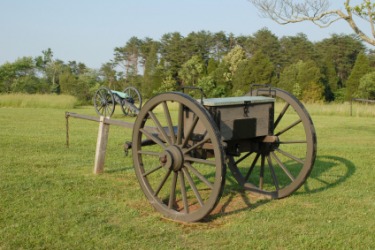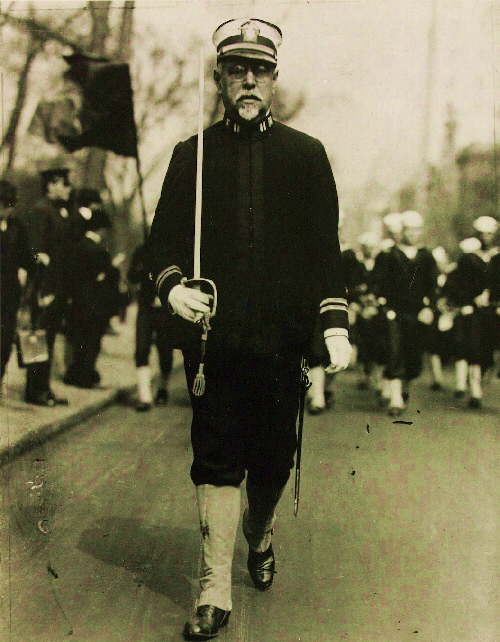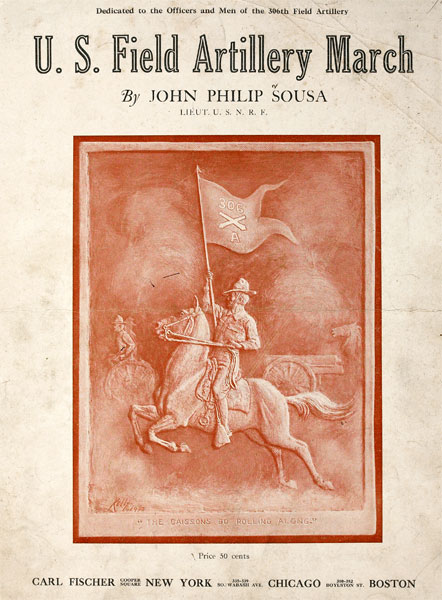QUOTE:
"Good music does not have an expiration date."AUTHOR: Unknown
MEANING OF THE QUOTE:
"Something of quality will last generations.That is what makes a piece of art 'classic.'"
COMPOSER
SOUSA
ARTILLERY MARCH
Up until WWII the field artillery is horse drawn.
This video shows a more modern treatment
then the march was originally meant for.
The march is based on the "Caisson Song"
Lieutenant in the Fifth Field Artillery (he later
became a Brigadier General), Edmund L.
Gruber (whose relative, Franz,
composed "Silent Night"),
with lyrical assistance from
 |
| http://www.arlingtoncemetery.net/wbryden.htm |
and Lieutenant
(later Major General)
(later Major General)
Robert Danford
 |
Robert M. Danford
at the Brazilian
Court Hotel in
Palm Beach
Bert Morgan,
Photographer
|
in the Philippines in March 1908
while waiting in the field for the rest of the
approaching caissons which were carrying
ammunition. The sounds of the wagons and
the men's shouts of "keep em rolling!"
was their inspiration for writing the
words and music for "The Caissons
Go Rolling Along." The tune quickly
became popular in field artillery units.
"Gruber taught the song to officers of the 1st Battalion as they
arrived at Fort Stotsenburg. Wrote Danford: 'A few evenings
later at the post reception for the new unit and adieu to the old,
The Caisson Song was given its first public rendition. Its
popularity was instantaneous, and almost in no time all six of
the regiments then composing the U.S. Field Artillery adopted it.'"
In 1917 (at the beginning of the US
involvement in WWI), during Lieutenant
(USN) John Philip Sousa's brief wartime
service in the navy, the Secretary of the
 |
| Josephus Daniels |
and Army Lieutenant
George Friedlander of the 306th
Field Artillery met him in New York
and asked him to create a march for
Friedlader's regiment built around the
theme of the "Caisson Song," a song
which Friedlander thought was quite
old, perhaps of Civil War origin, and was
unpublished with its unknown composer
dead. Sousa, who liked the original song
agreed to create a march from it. He
added his own original material, refined
the melody, changed the key, harmonic
structure, and gave it a snappier rhythm
then renamed and published it as
the "U.S. Field Artillery."
Sousa's artistic changes transformed this little
known song, first eagerly adopted by the
army's artillery units and then later by the
army as a whole, into the army's most popular
designated as the official Army song likely
because the lyrics were too closely
identified with the field artillery and
not the entire Army however the
current official song retains Gruber's
Later Sousa and Lieutenant Friedlander
were surprised to learn that the composer
of 'The Caisson Song' was still very much
alive and that the song was less than ten
years old. After learning the name of the
true composer Edmund Gruber, who it is
said had no objections to the use of his
song in this march which was serving
the army's purpose so admirably,
Sousa gave the royalties to him.
After the Sousa march was published,
Gruber's melody became so popular
that it became attractive to several
publishers who fought over it.

During the 1920's, the original melody
found its way into several song collections.
It is not known whether or not Gruber gave
written permission for the use of his song
in any of these publications, but he did
permit its incorporation into a volume
of West Point songs in 1921.
of West Point songs in 1921.
words and used it in radio advertising
making the song even more popular. After
receiving a free vacuum sweeper Gruber
started to endorse Hoover sweepers.

This did not please certain artillery
officers, who later asked Hoover to
refrain from the use of what they
Gruber gave up hope of ever claiming
royalties on his song when his personal
application for a copyright was denied
in 1930. However, in 1942 the sponsors
in 1930. However, in 1942 the sponsors
of the West Point publication re-
established their claim (as Gruber had
given them written permission to use his
song) and brought suit against the
one of the song's publishers. The court
ruled that the melody, which had been in
widespread use for over 30 years and had
in effect been dedicated to public use, with
no substantial objection by the composer,
constituted a practical abandonment
by that composer and was thus
by that composer and was thus
considered in the public domain.
The time-honored manuscript of his
original "Caisson Song" now hangs in the
library of the U.S. Army Artillery and
Missile School at Fort Sill, Oklahoma."
FIELD ARTILLARY MARCH LINKS


INFORMATION MOSTLY FROM:
http://lcweb2.loc.gov/diglib/ihas/loc.natlib.ihas.200152754/default.html
The U.S. Field Artillery march is set in
http://lcweb2.loc.gov/diglib/ihas/loc.natlib.ihas.200152754/default.html
The U.S. Field Artillery march is set in
duple time, beginning with another of
those Sousa explosions in A-flat that
get everybody's attention and let them
know from the first note that they are
about to hear something they will want
to remember. The most intriguing factor
in the evaluation of this march master-
piece is how perfectly the Sousa in it fits
the Gruber which it surrounds. All of it
simply belongs together, Sousa rising so
remarkably to the vitality and drive that
both the words and music of "The
Caisson Song" (as it is properly called)
so effectively generate. The first strain's
unrepeated thirty-two bars contain
unusual harmonic and rhythmic variety
for an initial Sousa statement:


Then, as if to gather listeners after this (for
him) rambling excursion, the second strain
is solidly simple, rhythmically contrasting,
and the ideal bridge to the featured song in
the trio. Inasmuch as it is a song, Sousa
had the words printed beneath the music of
the solo cornet part. Their performance at
top voice by all in the band except those
playing a minimum accompaniment adds an
important performance dimension to this
initial setting of the song. Then the master
of the break strain goes to work on
a compatible rhythmic figure:

and develops it for twelve bars of gathering
harmonic and rising dynamic excitement until
the whole thing explodes with one of
Sousa's most effective uses of that
favorite "surprise" chord:

He likes the idea so much that after
stretching it out twice he then hits the
listener with six short bursts of the same
chord and works his way right back to
"The Caisson Song" for its final full-throttle
conclusion by the whole band. Marches
more wide open or exciting than The U.S.
Field Artillery are not easy to find.[34] Once
again, as in that other swinging finale of
The High School Cadets, when Sousa is
through he has no need for that traditional
final note and it should never be added.
THE CAISSON SONG
 |
| An old artillery caisson on display at a national park. |
THE CAISSON SONG
Original (Though Not Official)
U.S. Army Song
With Lyrics



"The Caissons Go Rolling Along"
An Artillery Song,
dedicated to the U. S. Field Artillery
 |
| Edmund Gruber 1879-1941 |
Published 1921 by Shapiro,
Bernstein & Co., Inc., New York




In 1908, Lieutenant (later Brigadier General
and Commandant of the FA school) Edmund
Gruber, of the 5th FA Regiment stationed in
the Philippines, wrote "The Caissons Go
Rolling Along" as a regimental song
to be used at a unit review.
Over hill over dale
We have hit the dusty trail
We have hit the dusty trail
As our caissons go rolling along.
Up and down,
In and out,
In and out,
Countermarch and right about,
For it's hi-hi-hee
In the Fifth Artillery,
In the Fifth Artillery,
Shout out the number loud and strong.
Till our final ride,
It will always be our pride
It will always be our pride
To keep those caissons a rolling along.
(Keep them rolling—keep them rolling)
Keep those caissons a rolling along.
The lyrics we generally associate
with this song came about with the
Sousa version: The U.S. Field Artillery March.
VERSE 1:
Over hill, over dale,
As we hit the dusty trail
As we hit the dusty trail
And those Caissons go rolling along!
In and out, hear them shout,
Counter march and right about
Counter march and right about
Then it's hi, hi, hee,
In the field artillery
In the field artillery
Shout out your numbers loud and strong,
Where'er you go,
You will always know
You will always know
That those Caissons go rolling along!
VERSE 2:
In the storm, in the night,
Action left or action right
Action left or action right
See those Caissons go rolling along!
Limber front, limber rear,
Prepare to mount your cannoneer
Prepare to mount your cannoneer
And those Caissons go rolling along!


CHORUS:
Then it's hi, hi, hee,
In the field artillery
In the field artillery
Shout out your numbers loud and strong,
Where'er you go,
You will always know
You will always know
That those Caissons go rolling along!
VERSE 3:
Was it high, was it low,
Where the hell did that one go?
Where the hell did that one go?
As those Caissons go rolling along!
Was it left, was it right,
Now we won't get home tonight
Now we won't get home tonight
And those Caissons go rolling along!


CHORUS:
Then it's hi, hi, hee,
In the field artillery
In the field artillery
Shout out your numbers loud and strong,
Where'er you go,
You will always know
You will always know
LYRICS
http://plheineman.net/armygoesrolling.htm
LISTEN TO THE FIRST PART OF THE SONG
(VERSE-CHORUS-REFRAIN) HERE:
http://www.music.army.mil/music/play.asp?TheArmySong2013_BandAndChorus.mp3
http://www.music.army.mil/music/play.asp?TheArmySong2013_BandOnly.mp3
http://kynghistory.ky.gov/NR/rdonlyres/9CD28567-82E0-4F15-908D-9F27BFBA59A1/0/AmrySong.mp3
COMPLETE LYRICS
VERSE:
March along, sing our song,
With the Army of the free.
Count the brave, count the true,
Who have fought to victory.
We’re the Army and proud of our name!
LISTEN TO THE FIRST PART OF THE SONG
(VERSE-CHORUS-REFRAIN) HERE:
http://www.music.army.mil/music/play.asp?TheArmySong2013_BandAndChorus.mp3
http://www.music.army.mil/music/play.asp?TheArmySong2013_BandOnly.mp3
http://kynghistory.ky.gov/NR/rdonlyres/9CD28567-82E0-4F15-908D-9F27BFBA59A1/0/AmrySong.mp3
COMPLETE LYRICS
VERSE:
March along, sing our song,
With the Army of the free.
Count the brave, count the true,
Who have fought to victory.
We’re the Army and proud of our name!
We’re the Army and proudly proclaim:
FIRST CHORUS:
First to fight for the right,
And to build the Nation’s might,
And The Army Goes Rolling Along.
Proud of all we have done,
Fighting till the battle’s won,
And the Army Goes Rolling Along.
REFRAIN:
It's hi! hi! hey!
The Army's on its way.
Count off the cadence loud and strong;
For where'er we go,
You will always know
That The Army Goes Rolling Along.
SECOND CHORUS:
Valley Forge, Custer's ranks,
San Juan Hill and Patton's tanks,
And the Army went rolling along.
Minute men, from the start,
Always fighting from the heart,
And the Army keeps rolling along.
REFRAIN:
It's hi! hi! hey!
The Army's on its way.
Count off the cadence loud and strong;
For where'er we go,
You will always know
That The Army Goes Rolling Along.
THIRD CHORUS:
(slower, more freely)
Men in rags, men who froze,
Still that Army met its foes,
And the Army went rolling along.
Faith in God, then we're right,
And we'll fight with all our might,
As the Army keeps rolling along.
REFRAIN:
Then it's hi! hi! hey!
The Army's on its way.
Count off the cadence loud and strong;
(Two! three!)
For where'er we go,
You will always know
That the Army goes rolling along!
(Keep it rolling!)
And the Army goes rolling along!
THE ARMY GOES MARCHING ALONG
(Official Song of the U.S. Army)
"The Army Goes Rolling Along" is the
current official version, first authorized in
1956. The Caisson Song, while perhaps
more well known, was never really the
official U.S. Army song because
the lyrics were too closely associated with
the field artillery... not the entire army.
There is a slight difference between the songs
but not noticibly except for by a court judge
as the matter of just what the difference was
between them eventually ended up in
court. The official song (The Army Goes
Rolling Along) retains the author of The
Caisson Song's original music, but, along
with a few minor key changes and the
like, differs primarily in terms of its
more "acceptable" lyrics. To write
the lyrics, Harold W. Arberg,
a music advisor to the Adjutant General,
was brought in. With the new lyrics
complete the Secretary of the Army,
Wilber Marion Brucker,
 |
| Harold W. Arberg |
was brought in. With the new lyrics
complete the Secretary of the Army,
Wilber Marion Brucker,
 |
| Wilber Marion Brucker |
took center stage and
dedicated the music on Veterans Day,

ANOTHER VERSION
WITH DIFFERENT LYRICS
THE CAISSONS GO ROLLING ALONG
US Office of Emergency Management
World War II, circa 1942
Robert Weede, Vocal
World War II "music video"
produced by the US Government,
with footage mostly of jeeps and artillery.
(The lyrics for this version differ
from all of the three versions cited at Wikipedia
and at various other research sites.)
http://moretexastruth.blogspot.com/2008/12/us-army-song-as-army-goes-rolling-along.html
























